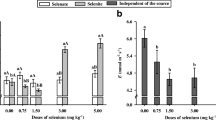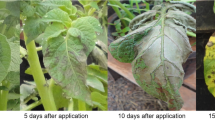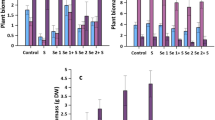Abstract
Potato plants are being supplemented with selenium (Se) to enrich tubers with Se for health benefits. Se is not an essential nutrient and interferes with the metabolism of sulfur (S) in plants. The objective of the present investigation was to study the activities of Se-independent glutathione peroxidase (Se-Ind-GPx), Se-dependent glutathione peroxidase (Se-Dep-GPx), and thioredoxin reductase (TRxR) enzymes in stored potato tubers grown on a non-Se-enriched field; and assess their relationship with tuber Se and S levels. The results indicate that these enzyme activities and the Se and S levels in the tubers were significantly influenced by genotype. Se-Dep-GPx activities were influenced by Se levels in the tubers. S content of tubers of all genotypes tested were below the critical nutrition concentration. In spite of this deficiency, the levels of S (which were very high in comparison with Se) influenced the activities of Se-Ind-GPx and TRxR in the tubers. Tubers of some of the genotypes tested can supply more than the recommended dietary allowance (RDA) of Se to adult humans.
Resumen
Las plantas de papa están siendo suplementadas con selenio (Se) para enriquecer los tubérculos con Se para beneficio de la salud. El Se no es un nutrimento esencial e interfiere con el metabolismo del azufre (S) en plantas. El objetivo de la presente investigación fue estudiar las actividades de las enzimas glutatión-peroxidasa independiente de Se (Se-Ind-GPx), glutatión-peroxidasa dependiente de Se (Se-Dep-GPx) y thioredoxin reductasa (TRxR) en tubérculos de papa almacenados provenientes de un campo no enriquecido con Se; y analizar su relación con los niveles de Se y S en el tubérculo. Los resultados indican que las actividades de estas enzimas y los niveles de Se y S en tubérculos fueron influenciados significativamente por el genotipo. Las actividades de Se-Dep-GPx se influenciaron por los niveles de Se en los tubérculos. El contenido de S en tubérculos de todos los genotipos probados estuvo debajo de la concentración crítica de nutrición. A pesar de esta deficiencia, los niveles de S (que fueron muy altos en comparación de Se) influenciaron las actividades de Se-Ind-GPx y TRxR en los tubérculos. Tubérculos de algunos de los genotipos probados pueden surtir mas de lo recomendado para la dieta de Se en humanos adultos.









Similar content being viewed by others
References
Anonymous. 2009. Peter Keogh & Sons launch ‘Selena’ potatoes naturally enriched with selenium. http://www.potatopro.com/Lists/Press%20Releases/Peter%20Keogh%20and%20Sons%2020090227.aspx#ixzz1OwSxo3a5. Accessed on June 10, 2011.
Baker, R.D., S.S. Baker, K. LaRosa, C. Whitney, and P.E. Newburger. 1993. Selenium regulation of glutathione peroxidase in human hepatoma cell line Hep3B. Archives of Biochemistry and Biophysics 304: 53–57.
Banze, M., and H. Follmann. 2000. Organelle-specific NADPH thioredoxin reductase in plant mitochondria. Journal of Plant Physiology 156: 126–129.
Beeor-Tzahar, T., G. Ben-Hayyim, D. Holland, Z. Faltin, and Y. Eshdat. 1995. A stress-associated citrus protein is a distinct plant phospholipid hydroperoxide glutathione peroxidase. FEBS Letters 366: 151–155.
Bethke, P.C., and S.H. Jansky. 2008. The effects of boiling and leaching on the content of potassium and other minerals in potatoes. Journal of Food Science 75: H80–H85.
Brown, T.A., and A. Shrift. 1982. Selenium: toxicity and tolerance in higher plants. Biological Reviews 57: 59–84.
Burk, R.F. 1983. Biological activity of selenium. Annual Review of Nutrition 3: 53–70.
Burk, R.F., and R.A. Lawrence. 1978. Nonselenium-dependent glutathione peroxidase. In Functions of glutathione in liver and kidney, ed. H. Sies and A. Wendel, 114–119. Berlin: Springer.
Burk, R.F., G.E. Olson, and K.E. Hill. 2006. Deletion of selenoprotein P gene in the mouse. In Selenium: Its molecular biology and role in human health, 2nd ed, ed. D.L. Hatfield, M.J. Berry, and V.N. Gladyshev, 111–122. New York: Springer.
Burnell, J.N. 1981. Methionyl-tRNA synthetase from Phaseolus aureus: purification and properties. Plant Physiology 67: 325–329.
Burnell, J.N., and A. Shrift. 1977. Cysteinyl tRNA synthetase from Phaseolus aureus. Plant Physiology 60: 670–674.
Chariot, P., and O. Bignani. 2003. Skeletal muscle disorders associated with selenium deficiency in humans. Muscle & Nerve 27: 662–668.
Dai, S., M. Saarinen, S. Ramaswamy, Y. Meyer, J.P. Jacquot, and H. Eklund. 1996. Crystal structure of Arabidopsis thaliana NADPH dependent thioredoxin reductase at 2.5 Å resolution. Journal of Molecular Biology 264: 1044–1057.
Davidian, J.-C., Y. Hatzfield, N. Cathala, A. Tagmount, and J.J. Vidmar. 2000. Sulfate uptake and transport in plants. In Sulfur nutrition and sulfur assimilation in higher plants: molecular, biochemical and physiological aspects, ed. C. Brunold, H. Rennenberg, L.J. De Kok, I. Stuhlen, and J.-C. Davidian, 1–19. Bern: Paul Haupt.
Dipierro, S., and S. De Leonardis. 1997. The ascorbate system and lipid peroxidation in stored potato (Solanum tuberosum L.) tubers. Journal of Experimental Botany 48: 779–783.
Ehrlich, S.D. 2009. Sulfur: Overview. http://www.umm.edu/altmed/articles/sulfur-000328.htm. Accessed on June 13, 2011.
Eshdat, Y., D. Holland, Z. Faltin, and G. Ben-Hayyim. 1997. Plant glutathione peroxidases. Physiologia Plantarum 100: 234–240.
Eustice, D.C., F.J. Kull, and A. Shrift. 1981. Selenium toxicity: Aminoacylation and peptide bond formation with selenomethionine. Plant Physiology 67: 1054–1058.
Faltin, Z., L. Camoin, G. Ben-Hayyim, A. Perl, T. Beeor-Tzahar, A.D. Strosberg, D. Holland, and Y. Eshdat. 1998. Cysteine is the presumed catalytic residue of Citrus sinensis phospholipid hydroperoxide glutathione peroxidase over-expressed under salt stress. Physiologia Plantarum 104: 741–746.
Ferri, T., G. Favero, and M. Frasconi. 2007. Selenium speciation in foods: Preliminary results on potatoes. Microchemical Journal 85: 222–227.
Food and Nutrition Board, Institute of Medicine. 2000. Dietary reference intakes for vitamin C, vitamin E, selenium, and carotenoids. Washington: National Academy Press.
Gelhaye, E., N. Rouhier, N. Navrot, and J.P. Jacquot. 2005. The plant thioredoxin system (Review). Cellular and Molecular Life Sciences 62: 24–35.
Gladyshev, V.N. 2006. Selenoproteins and selenoproteomes. In Selenium: Its molecular biology and role in human health, 2nd ed, ed. D.L. Hatfield, M.J. Berry, and V.N. Gladyshev, 99–114. New York: Springer.
Hatfield, D., I.S. Choi, S. Mischke, and L.D. Owens. 1992. Selenocysteinyl-tRNAs recognize UGA in Beta vulgaris, a higher plant, and in Gliocladium virens, a filamentous fungus. Biochemical and Biophysical Research Communications 184: 254–259.
Hell, R. 1997. Molecular physiology of plant sulfur metabolism (Review). Planta 202: 138–148.
Higdon, J., and V.J. Drake. 2007. Selenium. Micronutrient Information Center, Linus Pauling Institute, Oregon State University, USA. http://lpi.oregonstate.edu/infocenter/minerals/selenium/ . Accessed 28 September 2011.
Holland, D., G. Ben-Hayyim, Z. Faltin, L. Camoin, A.D. Strosberg, and Y. Eshdat. 1993. Molecular characterization of salt-stress-associated protein in citrus: protein and cDNA sequence homology to mammalian glutathione peroxidases. Plant Molecular Biology 21: 923–927.
Hopkins, L., S. Parmar, A. Blaszczyk, H. Hesse, R. Hoefgen, and M.J. Hawkesford. 2005. O-acetylserine and the regulation of expression of genes encoding components for sulfate uptake and assimilation in potato. Plant Physiology 138: 433–440.
Hsu, J.C. 1996. Multiple comparisons: theory and methods. Boca Raton: Chapman & Hall/CRC.
Jones, D.P., L. Eklöw, H. Thor, and S. Orrenius. 1981. Metabolism of hydrogen peroxide in isolated hepatocytes: relative contributions of catalase and glutathione peroxidase in decomposition of endogenously generated H2O2. Archives of Biochemistry and Biophysics 210: 505–516.
Kioussi, C., and P.D. Whanger. 2006. Selenoprotein W in development and oxidative stress. In Selenium: Its molecular biology and role in human health, 2nd ed, ed. D.L. Hatfield, M.J. Berry, and V.N. Gladyshev, 135–140. New York: Springer.
Kumar, G.N., and N.R. Knowles. 1993. Changes in lipid peroxidation and lipolytic and free-radical scavenging enzyme activities during aging and sprouting of potato (Solanum tuberosum) seed-tubers. Plant Physiology 102: 115–124.
Kumar, G.N., and N.R. Knowles. 1996. Oxidative stress results in increased sinks for metabolic energy during aging and sprouting of potato seed-tubers. Plant Physiology 112: 1301–1313.
Lawrence, R.A., L.K. Parkhill, and R.F. Burk. 1978. Hepatic cytosolic non selenium-dependent glutathione peroxidase activity: its nature and the effect of selenium deficiency. The Journal of Nutrition 108: 981–987.
Lei, X.G., W.H. Cheng, and J.P. McClung. 2007. Metabolic regulation and function of glutathione peroxidase-1. Annual Review of Nutrition 27: 41–61.
McDowell, L.R. 2003. Minerals in animal and human nutrition. Amsterdam: Elsevier.
Miller, R.O., and J. Kotoby-Amacher. 1995. Nitrate/perchloric wet ashing open vessel in western states laboratory proficiency testing program, soil & plant analytical methods, Version 2.00, Western States Program, pp 71–73.
Navarro-Alarcon, M., and M.C. Lopez-Martinez. 2000. Essentiality of selenium in the human body: Relationship with different diseases. Science of the Total Environment 249: 347–371.
Peixoto, F., J. Vicente, and V.M.C. Madeira. 2004. A comparative study of plant and animal mitochondria exposed to paraquat reveals that hydrogen peroxide is not related to the observed toxicity. Toxicology in Vitro 18: 733–739.
Perla, V., D.G. Holm, and S.S. Jayanty. 2012. Effects of cooking methods on polyphenols, pigments and antioxidant activity in potato tubers. LWT- Food Science and Technology 45: 161–171.
Reilly, C. 1996. Introduction. Selenium in food and health. London: Blackie Academic & Professional.
Rojas-Beltran, J.A., M. Dejaeghere, A.A. Kotb, and P.D. Jardin. 2000. Expression and activity of antioxidant enzymes during potato tuber dormancy. Potato Research 43: 383–393.
Rosenthal, M.D., and R.H. Glew. 2009. Medical biochemistry: Human metabolism in health and disease. Hoboken: Wiley.
Seppänen, M., M. Turakainen, and H. Hartikainen. 2003. Selenium effects on oxidative stress in potato. Plant Science 165: 311–319.
Shahpiri, A., B. Svensson, and C. Finnie. 2008. The NADPH-dependent thioredoxin reductase/thioredoxin system in germinating barley seeds: Gene expression, protein profiles, and interactions between isoforms of thioredoxin h and thioredoxin reductase. Plant Physiology 146: 789–799.
Shrift, A. 1969. Aspects of selenium metabolism in higher plants. Annual Review of Plant Physiology 20: 475–494.
Soltanpour, P.N., J.B. Jones Jr., and S.M. Workman. 1982. Optical emission spectrometry (chapter 3; method 3-5.5). In Methods of soil analysis, Part 2-Chemical and microbiological properties, 2nd ed, ed. A.L. Page, 59–62. Madison: American Society of Agronomy, Inc. and Soil Science Society of America Inc.
Spychalla, J.P., and S.L. Desborough. 1990. Superoxide dismutase, catalase, and α-tocopherol content of stored potato tubers. Plant Physiology 94: 1214–1218.
Stadtman, T.C. 1980. Selenium-dependent enzymes. Annual Review of Biochemistry 49: 93–110.
Tamura, T., and T.C. Stadtman. 1996. A new selenoprotein from human lung adenocarcinoma cells: purification, properties, and thioredoxin reductase activity. Proceedings of the National Academy of Sciences of the United States of America 93: 1006–1011.
Terry, N., A.M. Zayed, M.P. de Souza, and A.S. Tarun. 2000. Selenium in higher plants. Annual Review of Plant Physiology and Plant Molecular Biology 51: 401–432.
Turakainen, M., H. Hartikainen, P. Ekholm, and M.M. Seppanen. 2006. Distribution of selenium in different biochemical fractions and raw darkening degree of potato (Solanum tuberosum L.) tubers supplemented with selenate. Journal of Agricultural and Food Chemistry 54: 8617–8622.
Turkainen, M. 2007. Selenium and its effects on growth, yield and tuber quality in potato. Thesis, University of Helsinki, Finland.
Walworth, J.L., and J.E. Muniz. 1993. A compendium of tissue nutrient concentrations for field-grown potatoes. American Poato Journal 70: 579–597.
White, P.J., H.C. Bowen, P. Parmaguru, M. Fritz, W.P. Spracklen, R.E. Spidy, M.C. Meacham, A. Mead, M. Harriman, L.J. Trueman, B.M. Smith, B. Thomas, and M.R. Broadley. 2004. Interactions between selenium and sulphur nutrition in Astragalus thaliana. Journal of Experimental Botany 55: 1927–1937.
Acknowledgments
We thank Dr. Jim Self, Soil, Water, and Plant Testing Laboratory, Colorado State University, Fort Collins for estimating Se and S in the tuber samples; and Dr. Robert Davidson for proof-reading this manuscript. This work is partially supported by a grant from the Colorado Department of Agriculture through the USDA’s Specialty Crop Block Grant Program (award #10991) and Colorado Potato Administrative Committee Area II.
Disclaimers
None
Author information
Authors and Affiliations
Corresponding author
Rights and permissions
About this article
Cite this article
Perla, V., Holm, D.G. & Jayanty, S.S. Selenium and Sulfur Content and Activity of Associated Enzymes in Selected Potato Germplasm. Am. J. Pot Res 89, 111–120 (2012). https://doi.org/10.1007/s12230-011-9232-1
Published:
Issue Date:
DOI: https://doi.org/10.1007/s12230-011-9232-1




